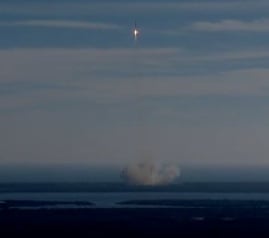This article is more than 1 year old
Elon Musk's Dragon capsule reaches orbit successfully
SpaceX control - not NASA - calls the plays
The Dragon space capsule built by SpaceX, the American private space company bankrolled and directed by famous PayPal nerdwealth tycoon Elon Musk, launched successfully from Cape Canaveral today.

Don't need no NASA launch controller
The Dragon, designed to carry cargo and then perhaps astronauts to the International Space Station (ISS), took off at 3:42 pm UK time atop a Falcon 9 rocket stack also manufactured by SpaceX. At 3:58, SpaceX launch control reported that Dragon had achieved orbit successfully: at 4:01, it was announced that the capsule had separated from the second stage of the Falcon.
Today's launch is the beginning of the first test flight of the Dragon, intended to prove that the capsule can fly successfully to orbit and return to Earth safely - in this case splashing down in the Pacific having orbited the planet twice. In future SpaceX has ambitions to bring the capsule down on land, saying that its "Draco" guidance rockets will permit it to come down accurately within a small target area.
As well as an existing Commercial Off The Shelf (COTS) deal to haul supplies and cargo to the ISS, SpaceX hopes to be selected for future "Commercial Crew" deals under which astronauts will be carried to and from the station. The company believes that both Falcon 9 and Dragon are capable, reliable and safe enough for manned flight.
Commercial Crew and Cargo are different from previous NASA operations, in that private companies will not only provide the rockets and spacecraft but operate them too. Previously, NASA has had much more of a role in designing and then running the craft used in programmes such as Shuttle and Apollo.
Elon Musk is known to believe that this is a very expensive and unwieldy way to carry out space exploration. SpaceX and its equipment were designed from the first to be efficient and affordable: the company has only 1,100 employees (as compared to the tens of thousands at NASA and the established rocket contractors) and the Falcon's Merlin engines use kerosene fuel rather than troublesome cryogenic hydrogen.
The ambitious new player is also known to have even loftier aspirations than replacing the Shuttle on trips to and from the ISS. In 2015, under current plans, the USA will select the new, Apollo style heavy lift rocket which will be needed to assemble manned missions beyond Earth orbit - to the asteroids or Mars, under President Obama's vision.
The old-style NASA Constellation plans for this were axed due to cost: but SpaceX is known to have massive successor designs to the Falcon 9 series rockets - dubbed Falcon X - which could do the job.
For now, though, SpaceX needs to maintain its place among its COTS competitors for the Commercial Crew and Cargo work before taking on the mighty mainstream US rocket biz for the 2015 heavy lift deal. ®
